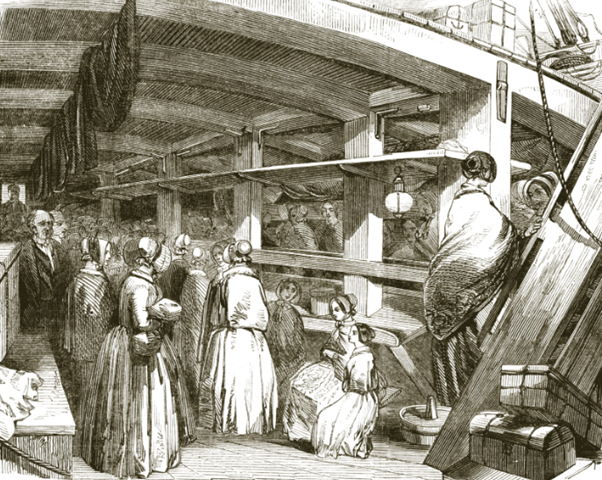The Floating Brothel
The term ‘floating brothel’ is now commonly used to refer to the convict ship, ‘Lady Juliana’, because of the sexual relations formed between the seamen and the convict women on the voyage. The term was coined by religious campaigners of the mid-19th century who thought that any sex outside of marriage was prostitution.
Gary L. Sturgess
2/8/20253 min read
Siân Rees popularised the term ‘floating brothel’ in her 2001 book about the Lady Juliana, a ship which carried female convicts to New South Wales in 1789, between the First and Second Fleets.
Rees revealed to her readers (many of whom were duly shocked) that a number of the women had sexual relations with the seamen throughout the voyage. (It was not the first bodice-ripper in the literature about convict transportation.)
In fact, cohabitation and sexual liaisons were common on convict ships until the 1820s, when Evangelical Christians launched a campaign against a practice they described as prostitution. And the Lady Juliana wasn’t the first – it is clear that there had been a great deal of sexual activity on the First Fleet.
The Evangelicals were successful in obtaining a government prohibition, although it would be some years before complaints about ‘prostitution’ disappeared, and human nature being what it is, sexual liaisons continued for some time thereafter.
The modern reader is shocked by this, in part because our prisons are not the relatively open institutions that gaols were in 18th century Britain. In English prisons, inmates freely associated with visitors and women often got pregnant.
But we are also wrong to assume that convict ships were prisons in the modern sense of that term. Convict transports were designed to carry prisoners safely and securely halfway around the world, and unless they were disorderly, the women would be given the freedom of the upper deck throughout the voyage, in the same way that free emigrants were. Under those conditions, it was inevitable that relationships would develop between young men and young women.
The term ‘floating brothel’ was first used in the Sydney press in 1834 in reference to the David Scott, an emigrant ship carrying out free single women. According to the Sydney Gazette:
'The extraordinary scenes of disgusting profligacy which are said to have been exhibited by a great number of the females of "good character and industrious habits," sent out by the London Emigration Committee, afford another instance of the prodigal and scandalous prostitution of the purposes for which the funds of the colony were voted by the council. The streets of London and the provincial towns seem to have been swept by this committee in order to enrich our country with that which was too vile and worthless to continue in Britain.' [1]
Other papers defended the women, arguing that the troublemakers were a small minority. But the Sydney Colonist was particularly vicious in its attacks on the reputations of these women, and it was this periodical which first coined the term ‘floating brothel’. In an article which appeared in January 1835, the paper challenging a member of the London Female Emigration Committee for supporting the scheme:
'Is Mr. Reynolds justified as a Christian in being a party to the formation of floating brothels, such as every female-emigration ship on the present system has turned out to be?' [2] (emphasis added)
The Colonist had been founded by the Presbyterian Minister, John Dunmore Lang, who strongly favoured family immigration. He had a particular reason for singling out the management of the David Scott: Lang had proposed to the Emigration Society that an associate should act as superintendent on this ship, and that this man’s son, a young minister of the Scottish Church, should serve as chaplain. The committee had declined his offer on the basis that the vast majority of the women were Anglican.
It was the anti-transportation campaigner, the Reverend John West, who first used the term in reference to convict ships. In his History of Tasmania, published in 1852, West harkened back to the sexual cohabitation that had been commonplace in the early years of transportation, adding bright splashes of colour to his account of how that system worked:
'. . . the officers and soldiers selected companions for the voyage, and a sentence of transportation included prostitution. It is not incredible that modest women rejected life on such terms, or preferred a public execution to the ignominy of a floating brothel. These practices were first tolerated as inevitable, and afterwards justified as politic. No conspiracy could be concealed, while the women were paramours and spies; and, when long detained, the population of the ship considerably augmented before she dropped anchor.' [3]
As with the campaign over the David Scott, the term ‘prostitution’ here meant any sexual relations outside of marriage.
The first person to apply this term to the Lady Juliana was Charles Bateson in his encyclopaedic work, The Convict Ships, and Rees borrowed it from him, seemingly unaware of its value-laden history.[4]
_________
[1] Sydney Gazette, 30 October 1834, p. 2.
[2] The Colonist, 15 January 1835, p. 2.
[3] John West, The History of Tasmania, Launceston: Henry Dowling, 1852, Vol.2, pp. 112-113.
[4] Charles Bateson, The Convict Ships: 1787-1868, Glasgow: Brown, Son & Ferguson Ltd., 1959, p. 106.


Contact us
Connect with us
Botany Baymen acknowledges the traditional custodians of country throughout Australia and respects their connection to land, water and community.
© Botany Baymen 2024. All rights reserved.
You may download, display, print and reproduce this content for your personal or non-commercial use but only in an unaltered form and with the copyright acknowledged.

